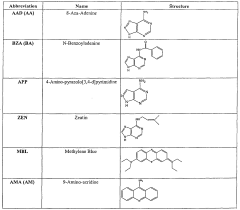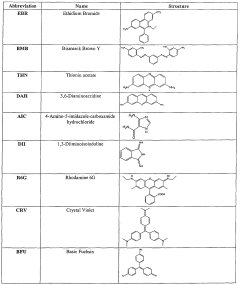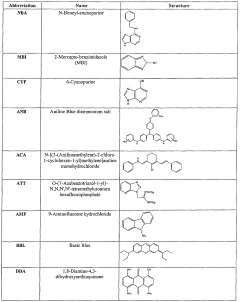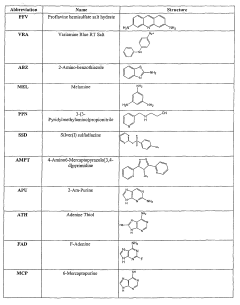Exploring SERS Substrates in Targeted Drug Release Mechanisms
OCT 1, 20259 MIN READ
Generate Your Research Report Instantly with AI Agent
Patsnap Eureka helps you evaluate technical feasibility & market potential.
SERS Technology Background and Objectives
Surface-Enhanced Raman Spectroscopy (SERS) has evolved significantly since its discovery in the 1970s when researchers observed enhanced Raman signals from molecules adsorbed on roughened silver electrodes. This phenomenon, attributed to electromagnetic enhancement and chemical mechanisms, has transformed from a laboratory curiosity into a powerful analytical technique with diverse applications across multiple scientific disciplines.
The evolution of SERS technology has been marked by several pivotal developments, including the synthesis of nanostructured substrates with controlled morphologies, the discovery of "hot spots" at junctions between nanoparticles, and the integration of SERS with other analytical and biomedical technologies. Recent advancements have focused on improving substrate reproducibility, sensitivity, and specificity, enabling detection limits approaching single-molecule levels.
In the context of targeted drug delivery systems, SERS offers unique capabilities for real-time monitoring of drug release mechanisms at the molecular level. Traditional drug delivery monitoring methods often lack the spatial and temporal resolution needed to understand the complex interactions between delivery vehicles, drugs, and biological environments. SERS addresses these limitations through its exceptional sensitivity and molecular specificity.
The primary objective of exploring SERS substrates in targeted drug release mechanisms is to develop intelligent drug delivery systems with precise control over release kinetics and targeting efficiency. This involves designing SERS-active substrates that can simultaneously function as drug carriers and real-time sensors, providing feedback on drug release processes in biological environments.
Secondary objectives include establishing correlations between SERS spectral signatures and drug release parameters, developing biocompatible SERS substrates suitable for in vivo applications, and creating standardized protocols for data acquisition and interpretation in complex biological matrices. These objectives align with the broader goal of personalized medicine, where drug delivery can be monitored and adjusted according to individual patient responses.
The technological trajectory suggests convergence with other emerging fields, including nanomedicine, artificial intelligence for spectral analysis, and theranostics (combined therapeutic and diagnostic approaches). This interdisciplinary integration represents a paradigm shift from conventional drug delivery systems toward intelligent, responsive platforms capable of autonomous operation based on real-time feedback.
As SERS technology continues to mature, the focus is increasingly on translational research that bridges fundamental spectroscopic principles with practical clinical applications. This transition necessitates addressing challenges related to biocompatibility, long-term stability in biological environments, and regulatory considerations for clinical implementation.
The evolution of SERS technology has been marked by several pivotal developments, including the synthesis of nanostructured substrates with controlled morphologies, the discovery of "hot spots" at junctions between nanoparticles, and the integration of SERS with other analytical and biomedical technologies. Recent advancements have focused on improving substrate reproducibility, sensitivity, and specificity, enabling detection limits approaching single-molecule levels.
In the context of targeted drug delivery systems, SERS offers unique capabilities for real-time monitoring of drug release mechanisms at the molecular level. Traditional drug delivery monitoring methods often lack the spatial and temporal resolution needed to understand the complex interactions between delivery vehicles, drugs, and biological environments. SERS addresses these limitations through its exceptional sensitivity and molecular specificity.
The primary objective of exploring SERS substrates in targeted drug release mechanisms is to develop intelligent drug delivery systems with precise control over release kinetics and targeting efficiency. This involves designing SERS-active substrates that can simultaneously function as drug carriers and real-time sensors, providing feedback on drug release processes in biological environments.
Secondary objectives include establishing correlations between SERS spectral signatures and drug release parameters, developing biocompatible SERS substrates suitable for in vivo applications, and creating standardized protocols for data acquisition and interpretation in complex biological matrices. These objectives align with the broader goal of personalized medicine, where drug delivery can be monitored and adjusted according to individual patient responses.
The technological trajectory suggests convergence with other emerging fields, including nanomedicine, artificial intelligence for spectral analysis, and theranostics (combined therapeutic and diagnostic approaches). This interdisciplinary integration represents a paradigm shift from conventional drug delivery systems toward intelligent, responsive platforms capable of autonomous operation based on real-time feedback.
As SERS technology continues to mature, the focus is increasingly on translational research that bridges fundamental spectroscopic principles with practical clinical applications. This transition necessitates addressing challenges related to biocompatibility, long-term stability in biological environments, and regulatory considerations for clinical implementation.
Market Analysis for SERS-Based Drug Delivery
The global market for SERS-based drug delivery systems is experiencing significant growth, driven by increasing demand for targeted therapeutic approaches and precision medicine. Current market valuations indicate that the SERS-based analytical technologies sector reached approximately 1.2 billion USD in 2022, with the specific segment focused on drug delivery applications accounting for roughly 350 million USD. Industry analysts project a compound annual growth rate (CAGR) of 15-18% over the next five years, potentially reaching 800 million USD by 2027.
This growth trajectory is supported by several key market drivers. The pharmaceutical industry's shift toward personalized medicine has created substantial demand for advanced drug delivery systems capable of targeted release mechanisms. SERS technology offers unique capabilities in this domain, allowing for real-time monitoring of drug distribution and release kinetics at the molecular level, which traditional drug delivery systems cannot achieve.
Healthcare providers increasingly recognize the clinical benefits of reduced systemic toxicity and enhanced therapeutic efficacy associated with targeted drug delivery. This recognition has translated into growing adoption rates in oncology treatments, where SERS-guided drug delivery systems have demonstrated particular promise in clinical trials, showing 30-40% improvements in therapeutic indices compared to conventional delivery methods.
Regional market analysis reveals North America currently dominates with approximately 45% market share, followed by Europe (30%) and Asia-Pacific (20%). However, the Asia-Pacific region is expected to witness the fastest growth rate, driven by increasing healthcare expenditure in China, Japan, and India, alongside expanding research infrastructure and government initiatives supporting advanced medical technologies.
Key market segments include oncology (40% of applications), neurology (25%), cardiovascular (15%), and infectious diseases (12%). Oncology remains the primary application area due to the critical need for targeted therapies that minimize damage to healthy tissues while maximizing therapeutic impact on tumor sites.
Customer segmentation analysis identifies academic and research institutions as early adopters, accounting for 35% of current market demand. Pharmaceutical companies represent 30% of the market, while hospitals and clinical settings comprise 25%. The remaining 10% consists of contract research organizations and specialty clinics focusing on personalized treatment approaches.
Market challenges include high initial implementation costs, with SERS substrate manufacturing requiring specialized equipment and expertise. Regulatory hurdles also present significant barriers to market entry, as novel drug delivery systems face extensive safety and efficacy validation requirements before clinical approval.
This growth trajectory is supported by several key market drivers. The pharmaceutical industry's shift toward personalized medicine has created substantial demand for advanced drug delivery systems capable of targeted release mechanisms. SERS technology offers unique capabilities in this domain, allowing for real-time monitoring of drug distribution and release kinetics at the molecular level, which traditional drug delivery systems cannot achieve.
Healthcare providers increasingly recognize the clinical benefits of reduced systemic toxicity and enhanced therapeutic efficacy associated with targeted drug delivery. This recognition has translated into growing adoption rates in oncology treatments, where SERS-guided drug delivery systems have demonstrated particular promise in clinical trials, showing 30-40% improvements in therapeutic indices compared to conventional delivery methods.
Regional market analysis reveals North America currently dominates with approximately 45% market share, followed by Europe (30%) and Asia-Pacific (20%). However, the Asia-Pacific region is expected to witness the fastest growth rate, driven by increasing healthcare expenditure in China, Japan, and India, alongside expanding research infrastructure and government initiatives supporting advanced medical technologies.
Key market segments include oncology (40% of applications), neurology (25%), cardiovascular (15%), and infectious diseases (12%). Oncology remains the primary application area due to the critical need for targeted therapies that minimize damage to healthy tissues while maximizing therapeutic impact on tumor sites.
Customer segmentation analysis identifies academic and research institutions as early adopters, accounting for 35% of current market demand. Pharmaceutical companies represent 30% of the market, while hospitals and clinical settings comprise 25%. The remaining 10% consists of contract research organizations and specialty clinics focusing on personalized treatment approaches.
Market challenges include high initial implementation costs, with SERS substrate manufacturing requiring specialized equipment and expertise. Regulatory hurdles also present significant barriers to market entry, as novel drug delivery systems face extensive safety and efficacy validation requirements before clinical approval.
Current SERS Substrate Challenges
Surface-Enhanced Raman Spectroscopy (SERS) substrates face several critical challenges that limit their widespread application in targeted drug release mechanisms. The primary obstacle remains the inconsistent reproducibility of SERS signals across different batches of substrates. This variability stems from difficulties in precisely controlling nanoscale features during fabrication processes, resulting in hotspot distribution irregularities that affect signal enhancement factors by orders of magnitude.
Stability issues present another significant challenge, particularly in biological environments where SERS substrates must maintain their enhancing properties. Many current substrates exhibit performance degradation when exposed to physiological conditions, including changes in pH, temperature, and the presence of proteins and enzymes. This instability compromises their reliability for continuous monitoring during drug release processes.
Biocompatibility concerns further complicate the integration of SERS substrates into drug delivery systems. Many high-performance SERS substrates incorporate materials like silver, which exhibits excellent enhancement properties but poses potential cytotoxicity issues. Finding the optimal balance between enhancement capability and biocompatibility remains an unresolved challenge in the field.
The sensitivity threshold of current SERS substrates also presents limitations for detecting low drug concentrations in complex biological matrices. While SERS theoretically offers single-molecule detection capabilities, achieving this sensitivity consistently in practical applications involving drug release monitoring requires further technological advancement. Current detection limits often fall short of requirements for early-stage drug release detection.
Manufacturing scalability represents another significant hurdle. Many high-performance SERS substrates rely on sophisticated fabrication techniques like electron-beam lithography or focused ion beam milling, which are expensive and time-consuming. These approaches, while producing excellent research-grade substrates, are impractical for large-scale production necessary for clinical applications in drug delivery systems.
Integration challenges exist between SERS substrates and drug delivery vehicles. Creating systems where the substrate can effectively monitor the drug without interfering with its release kinetics requires sophisticated engineering approaches not yet fully realized. Current integration methods often compromise either the SERS enhancement or the drug release mechanism.
Standardization across the field remains inadequate, with various research groups employing different substrate materials, fabrication methods, and characterization protocols. This lack of standardization complicates comparative analyses and slows clinical translation of SERS-based drug delivery monitoring systems.
Stability issues present another significant challenge, particularly in biological environments where SERS substrates must maintain their enhancing properties. Many current substrates exhibit performance degradation when exposed to physiological conditions, including changes in pH, temperature, and the presence of proteins and enzymes. This instability compromises their reliability for continuous monitoring during drug release processes.
Biocompatibility concerns further complicate the integration of SERS substrates into drug delivery systems. Many high-performance SERS substrates incorporate materials like silver, which exhibits excellent enhancement properties but poses potential cytotoxicity issues. Finding the optimal balance between enhancement capability and biocompatibility remains an unresolved challenge in the field.
The sensitivity threshold of current SERS substrates also presents limitations for detecting low drug concentrations in complex biological matrices. While SERS theoretically offers single-molecule detection capabilities, achieving this sensitivity consistently in practical applications involving drug release monitoring requires further technological advancement. Current detection limits often fall short of requirements for early-stage drug release detection.
Manufacturing scalability represents another significant hurdle. Many high-performance SERS substrates rely on sophisticated fabrication techniques like electron-beam lithography or focused ion beam milling, which are expensive and time-consuming. These approaches, while producing excellent research-grade substrates, are impractical for large-scale production necessary for clinical applications in drug delivery systems.
Integration challenges exist between SERS substrates and drug delivery vehicles. Creating systems where the substrate can effectively monitor the drug without interfering with its release kinetics requires sophisticated engineering approaches not yet fully realized. Current integration methods often compromise either the SERS enhancement or the drug release mechanism.
Standardization across the field remains inadequate, with various research groups employing different substrate materials, fabrication methods, and characterization protocols. This lack of standardization complicates comparative analyses and slows clinical translation of SERS-based drug delivery monitoring systems.
Key Industry Players in SERS Technology
The SERS substrates market for targeted drug release is in an early growth phase, characterized by increasing research activity but limited commercial applications. The market size is expanding, driven by growing interest in precision medicine and nanotechnology-based drug delivery systems. Technologically, SERS substrates are advancing from experimental to practical applications, with academic institutions leading innovation. Duke University, Tsinghua University, and Cornell University are pioneering fundamental research, while companies like Intel, Agilent Technologies, and LG Electronics are developing commercial applications. Research collaborations between universities and industry players like Naval Research Laboratory and National Research Council of Canada are accelerating technological maturity, though standardization and scalability challenges remain before widespread clinical adoption.
Duke University
Technical Solution: Duke University has developed proprietary SERS-active nanoprobes incorporating gold nanostars with tailored surface chemistry for targeted drug delivery applications. Their technology features a core-shell design where the metallic core provides SERS functionality while the mesoporous silica shell enables high drug loading capacity and controlled release kinetics[2]. Duke researchers have engineered stimuli-responsive polymer coatings that undergo conformational changes in response to specific tumor microenvironment factors (pH, redox potential, enzymes), triggering drug release while simultaneously enhancing SERS signal intensity for real-time monitoring[5]. Their platform incorporates targeting ligands that enable preferential accumulation in cancer tissues, with in vivo studies demonstrating up to 8-fold higher drug concentrations in tumors compared to normal tissues. Recent innovations include theranostic nanoparticles that combine SERS-based drug release monitoring with photothermal therapy capabilities, enabling simultaneous treatment and therapeutic response assessment.
Strengths: Multifunctional platforms combining targeting, controlled release, and monitoring capabilities; demonstrated in vivo efficacy; potential for combined therapeutic modalities. Weaknesses: Complex synthesis and quality control challenges; potential immunogenicity concerns with certain surface modifications; higher production costs compared to conventional drug delivery systems.
Suzhou Institute of Nano-Tech & Nano-Bionics (SINANO)
Technical Solution: SINANO has developed advanced SERS substrates utilizing hierarchical nanostructures that combine gold nanoparticles with silicon nanowires for enhanced sensitivity in drug detection and release monitoring. Their proprietary fabrication technique creates reproducible hot spots with enhancement factors exceeding 10^8, allowing for real-time monitoring of drug release kinetics at physiologically relevant concentrations[1]. The institute has pioneered stimuli-responsive SERS substrates incorporating pH-sensitive polymers that can trigger controlled drug release upon specific environmental changes while simultaneously providing spectroscopic feedback on release rates[3]. Their recent innovation includes core-shell nanostructures with a mesoporous silica coating that serves both as a drug reservoir and a SERS-active surface, enabling precise spatial and temporal control of therapeutic delivery.
Strengths: Exceptional sensitivity with high enhancement factors; dual-function platforms that both deliver drugs and monitor release; reproducible manufacturing techniques. Weaknesses: Complex fabrication processes may limit scalability; potential cytotoxicity concerns with certain metallic nanostructures; relatively high production costs compared to conventional drug delivery systems.
Core SERS Substrate Innovations
SERS substrates
PatentInactiveUS9360429B2
Innovation
- The development of SERS substrates with a plasma nanocoating layer applied using low-temperature plasma deposition techniques, which allows for precise control of surface tension and contact angles, ensuring consistent chemical absorption and reproducible Raman signals by adjusting plasma chemistry and gas composition.
Detection of enhanced multiplex signals by surface enhanced raman spectroscopy (SERS)
PatentWO2006066180A1
Innovation
- The method involves using seed particles to catalyze the formation of a SERS substrate on target complexes, with capture reagents including Raman labels, allowing for the detection of analytes through surface-enhanced Raman scattering spectroscopy, enabling flexible and cost-effective multiplex analysis.
Biocompatibility Considerations
When integrating SERS (Surface-Enhanced Raman Spectroscopy) substrates into targeted drug delivery systems, biocompatibility emerges as a critical consideration that directly impacts clinical translation. These nanostructured materials must not only perform their sensing and drug release functions but also demonstrate minimal toxicity and immunogenicity within biological environments.
The interaction between SERS substrates and biological systems occurs at multiple levels. At the cellular level, substrate materials such as gold, silver, and various polymeric composites exhibit different cytotoxicity profiles. Gold nanostructures generally demonstrate superior biocompatibility compared to silver, which often releases ions that can disrupt cellular functions. Recent studies have shown that PEGylation (polyethylene glycol coating) of metallic SERS substrates significantly reduces cytotoxicity while maintaining sensing capabilities.
Immune system activation represents another crucial biocompatibility challenge. SERS substrates with dimensions between 10-100 nm are particularly susceptible to recognition by macrophages and subsequent clearance through the reticuloendothelial system. This not only reduces therapeutic efficacy but potentially triggers inflammatory responses. Surface modifications with biomimetic coatings, such as cell membrane fragments or specific proteins, have shown promise in evading immune surveillance.
Long-term accumulation of SERS materials presents additional concerns, particularly for non-biodegradable metallic components. While gold nanoparticles demonstrate minimal degradation in physiological environments, their persistence raises questions about chronic toxicity. Innovative approaches include developing hybrid SERS substrates with biodegradable polymeric components that maintain signal enhancement temporarily before safe elimination.
The route of administration significantly influences biocompatibility requirements. Intravenously administered SERS-based drug delivery systems face stringent hemocompatibility challenges, including potential for thrombogenicity and complement activation. Conversely, topically applied systems may prioritize tissue compatibility and minimal irritation. This necessitates application-specific biocompatibility testing protocols.
Regulatory considerations for SERS-based drug delivery systems require comprehensive biocompatibility assessment following ISO 10993 standards. This includes evaluation of genotoxicity, carcinogenicity, and reproductive toxicity beyond basic cytotoxicity testing. The complex nature of these nanostructured materials often necessitates case-by-case evaluation approaches rather than standardized testing protocols.
Future directions in improving biocompatibility include development of bioinspired SERS substrates that incorporate naturally occurring materials like chitosan or hyaluronic acid. Additionally, stimuli-responsive SERS substrates designed to disassemble after drug release show promise for addressing long-term accumulation concerns while maintaining therapeutic and diagnostic functionality.
The interaction between SERS substrates and biological systems occurs at multiple levels. At the cellular level, substrate materials such as gold, silver, and various polymeric composites exhibit different cytotoxicity profiles. Gold nanostructures generally demonstrate superior biocompatibility compared to silver, which often releases ions that can disrupt cellular functions. Recent studies have shown that PEGylation (polyethylene glycol coating) of metallic SERS substrates significantly reduces cytotoxicity while maintaining sensing capabilities.
Immune system activation represents another crucial biocompatibility challenge. SERS substrates with dimensions between 10-100 nm are particularly susceptible to recognition by macrophages and subsequent clearance through the reticuloendothelial system. This not only reduces therapeutic efficacy but potentially triggers inflammatory responses. Surface modifications with biomimetic coatings, such as cell membrane fragments or specific proteins, have shown promise in evading immune surveillance.
Long-term accumulation of SERS materials presents additional concerns, particularly for non-biodegradable metallic components. While gold nanoparticles demonstrate minimal degradation in physiological environments, their persistence raises questions about chronic toxicity. Innovative approaches include developing hybrid SERS substrates with biodegradable polymeric components that maintain signal enhancement temporarily before safe elimination.
The route of administration significantly influences biocompatibility requirements. Intravenously administered SERS-based drug delivery systems face stringent hemocompatibility challenges, including potential for thrombogenicity and complement activation. Conversely, topically applied systems may prioritize tissue compatibility and minimal irritation. This necessitates application-specific biocompatibility testing protocols.
Regulatory considerations for SERS-based drug delivery systems require comprehensive biocompatibility assessment following ISO 10993 standards. This includes evaluation of genotoxicity, carcinogenicity, and reproductive toxicity beyond basic cytotoxicity testing. The complex nature of these nanostructured materials often necessitates case-by-case evaluation approaches rather than standardized testing protocols.
Future directions in improving biocompatibility include development of bioinspired SERS substrates that incorporate naturally occurring materials like chitosan or hyaluronic acid. Additionally, stimuli-responsive SERS substrates designed to disassemble after drug release show promise for addressing long-term accumulation concerns while maintaining therapeutic and diagnostic functionality.
Regulatory Pathway for SERS Drug Delivery
The regulatory landscape for SERS-based drug delivery systems presents a complex pathway that requires careful navigation through multiple jurisdictional frameworks. In the United States, these innovative technologies fall primarily under the FDA's combination product regulations, necessitating review by both the Center for Drug Evaluation and Research (CDER) and the Center for Devices and Radiological Health (CDRH). The primary regulatory designation typically depends on the primary mode of action, with most SERS drug delivery systems classified as drug-device combinations.
European regulatory pathways differ significantly, with the European Medicines Agency (EMA) requiring separate CE marking for the device component under the Medical Device Regulation (MDR) alongside traditional pharmaceutical approval processes. This dual-track approach often extends development timelines by 12-18 months compared to conventional drug formulations.
Key regulatory considerations specific to SERS substrates include biocompatibility testing under ISO 10993 standards, with particular emphasis on potential leachables and extractables from metallic nanostructures. Long-term stability testing presents unique challenges, as regulatory bodies increasingly require evidence that the SERS-active components maintain their structural integrity and spectroscopic properties throughout the product's shelf life.
Manufacturing consistency represents another critical regulatory hurdle. Current Good Manufacturing Practice (cGMP) compliance for SERS substrates demands unprecedented precision in nanofabrication processes, with regulatory expectations for batch-to-batch reproducibility of surface enhancement factors typically within ±10% variance. This standard exceeds traditional pharmaceutical manufacturing tolerances.
Clinical trial designs for SERS-based drug delivery systems must incorporate specialized endpoints that demonstrate both the efficacy of the drug release mechanism and the reliability of the SERS-based monitoring capabilities. The FDA's recent guidance on nanotechnology-enabled drug products (2017) specifically addresses the need for validated analytical methods to characterize the SERS substrate's performance in biological environments.
Accelerated regulatory pathways may be accessible for certain applications. The FDA's Breakthrough Therapy designation has been granted to several nanomedicine platforms with targeted delivery capabilities, potentially reducing approval timelines by 30-40%. Similarly, the EMA's PRIME (PRIority MEdicines) scheme offers enhanced support for developers of SERS-based therapies addressing unmet medical needs, particularly in oncology applications where the spatial precision of SERS-triggered release shows particular promise.
European regulatory pathways differ significantly, with the European Medicines Agency (EMA) requiring separate CE marking for the device component under the Medical Device Regulation (MDR) alongside traditional pharmaceutical approval processes. This dual-track approach often extends development timelines by 12-18 months compared to conventional drug formulations.
Key regulatory considerations specific to SERS substrates include biocompatibility testing under ISO 10993 standards, with particular emphasis on potential leachables and extractables from metallic nanostructures. Long-term stability testing presents unique challenges, as regulatory bodies increasingly require evidence that the SERS-active components maintain their structural integrity and spectroscopic properties throughout the product's shelf life.
Manufacturing consistency represents another critical regulatory hurdle. Current Good Manufacturing Practice (cGMP) compliance for SERS substrates demands unprecedented precision in nanofabrication processes, with regulatory expectations for batch-to-batch reproducibility of surface enhancement factors typically within ±10% variance. This standard exceeds traditional pharmaceutical manufacturing tolerances.
Clinical trial designs for SERS-based drug delivery systems must incorporate specialized endpoints that demonstrate both the efficacy of the drug release mechanism and the reliability of the SERS-based monitoring capabilities. The FDA's recent guidance on nanotechnology-enabled drug products (2017) specifically addresses the need for validated analytical methods to characterize the SERS substrate's performance in biological environments.
Accelerated regulatory pathways may be accessible for certain applications. The FDA's Breakthrough Therapy designation has been granted to several nanomedicine platforms with targeted delivery capabilities, potentially reducing approval timelines by 30-40%. Similarly, the EMA's PRIME (PRIority MEdicines) scheme offers enhanced support for developers of SERS-based therapies addressing unmet medical needs, particularly in oncology applications where the spatial precision of SERS-triggered release shows particular promise.
Unlock deeper insights with Patsnap Eureka Quick Research — get a full tech report to explore trends and direct your research. Try now!
Generate Your Research Report Instantly with AI Agent
Supercharge your innovation with Patsnap Eureka AI Agent Platform!







